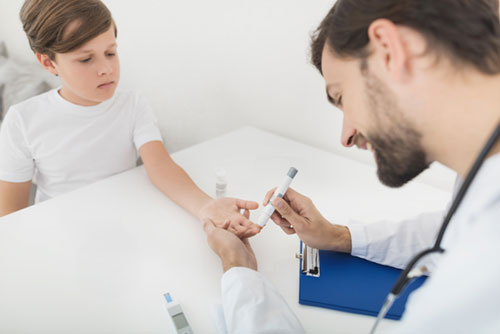Greetings to our spirited KWAY readers!
Every November, the medical community bands together over a flutter of diabetes awareness campaigns, flyers, posters and news columns. This is our chance to disseminate facts and bust myths about this chronic metabolic condition. Diabetes as we know, is characterized by high blood glucose levels (hyperglycaemia) which in the long run, adversely affects the eyes, kidneys, nerves, heart and blood vessels.

Type 1 diabetes is known to commonly affect children wherein the pancreas produces little or no insulin. The presenting symptoms include excessive urination, loss of weight, excessive thirst, fatigue, lethargy, irritability, behavioural changes and tiredness. In some children, the first and initial presentation is as DKA or diabetic ketoacidosis, a medical emergency and a grave complication of hyperglycaemia. It can be precipitated by stress, infections, injuries or missed/erratic insulin doses in a previously diagnosed child with type 1 diabetes.
What Are the Warning Signs of DKA?
The symptoms of DKA manifest as sugar, ketones and acids mount up in the body due to insulin deficiency. The symptoms include excessive urination, excessive thirst, dehydration, nausea, vomiting, abdominal pain, lethargy, drowsiness, fruity breath and rapid, shallow breathing. If left untreated, it can progress to diabetic coma resulting in ominous outcomes.
What Tests Are Done to Diagnose DKA?
When a child presents to the emergency room (ER) with red flag signs of DKA, an array of testing is done promptly including blood sugar (with point-of-care glucometer device), electrolytes, renal function tests, pH and blood gas analysis, urine sugar, urine ketones and basic haematology panel. DKA is characterised by blood glucose > 200 mg/dL, metabolic acidosis – venous pH < 7.3 or serum bicarbonate < 15 mEq/L and presence of ketones in the blood (> 3 mmol/L beta-hydroxybutyrate) or urine (“moderate or large” urine ketones).
How Is DKA Treated?
DKA is a medical emergency. A child with DKA requires frequent clinical assessments and high-level nursing care. Therefore, after initial stabilization and general resuscitation in the ER, such children are managed usually in a high-dependency unit or a pediatric intensive care unit as per standard internationally approved protocols. A multi-disciplinary team comprising of a pediatrician, pediatric intensivist, critical care nurses, clinical pharmacist and pediatric endocrinologist are involved in the care of such children.
The therapeutic goals of DKA treatment are:
- reduce blood sugar levels
- correct dehydration
Blood sugar control is achieved by administering regular insulin intravenously as a continuous drip. The dose of insulin is titrated according to the sugar levels and select biochemical parameters (pH, bicarbonate) which are monitored periodically. Dehydration correction is achieved by a stringently calculated intravenous fluid dosing protocol. A switch to subcutaneous insulin is done and diet re-introduced once the DKA emergency is mitigated.
How Can DKA Be Prevented?
The key to preventing DKA is good glycaemic control. Your doctor will provide a child care plan focusing on the following:
- Insulin
The care plan involves an appropriate subcutaneous insulin prescription (pre-meals short acting insulin and long-acting basal insulin at night). It is imperative to train the caregivers in insulin administration using pen devices, use of a glucometer to monitor blood glucose levels and checking urine for sugar/ketones using urinary dipstick testing strips. - Diet
Keep track of the carbohydrate count and limit sugary treats/empty calories. Include “super-foods” with low glycaemic index (whole grains, legumes and lentils, nuts, fruits and veggies, low fat dairy, etc.) in the diet. - Exercise
Encourage 30 minutes of free play in toddlers and 60 minutes of physical activity in children and adolescents. Running, swimming, cycling and yoga are fun activities to engage them in. - Contingency Plans
All children with type 1 diabetes should have an ID with emergency contact number. During sick days, we need to keep a closer watch on their sugar levels. Primary caregivers, adult family members, teachers and school staff need to be educated and counselled about the warning signs of DKA. They should know when and where to seek emergency assistance for the same. - Support and Periodic Follow-Up
A diagnosis of type 1 diabetes can be quite overwhelming for the child and family to deal with. Hence, family support, education and regular follow-up are essential to ensure compliance with therapy. This mandates unstinted backing from the right team of doctors with the right resources and knowledge. Our pediatric team at Kauvery is committed to this very cause. Our efforts shall help keep your children hale and hearty.We are in this together!

Dr. Lakshmi Prashant
Consultant Pediatrician
Kauvery Hospital Chennai

